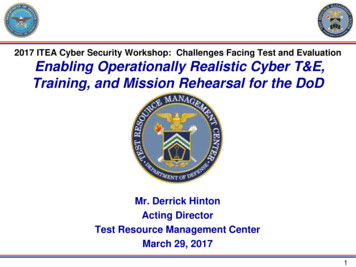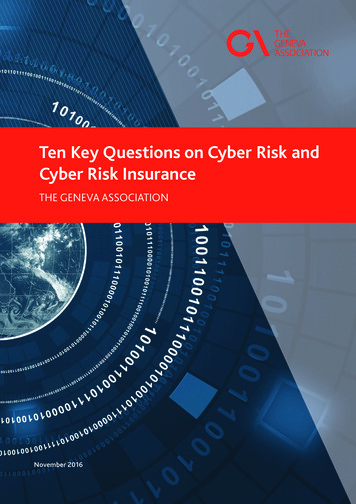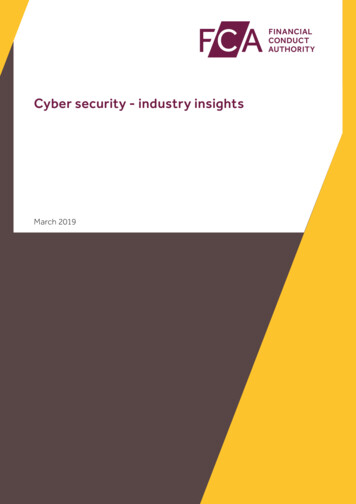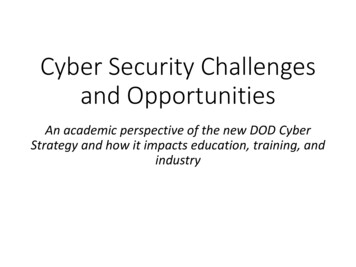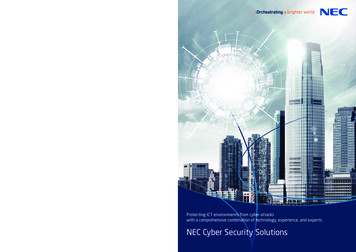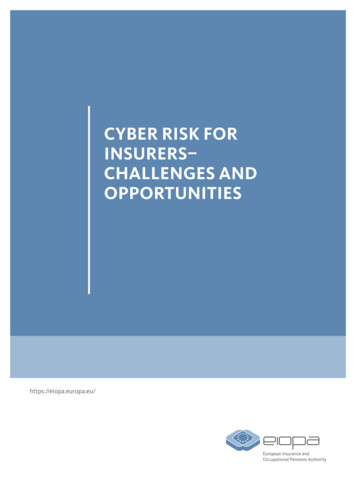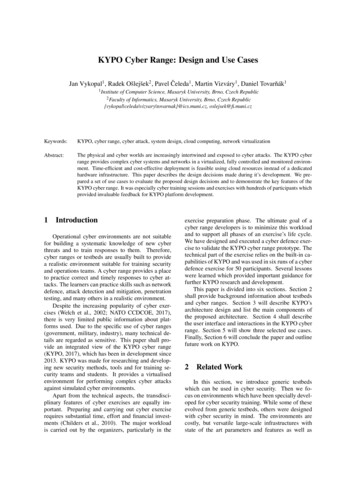
Transcription
KYPO Cyber Range: Design and Use CasesJan Vykopal1 , Radek Ošlejšek2 , Pavel Čeleda1 , Martin Vizváry1 , Daniel Tovarňák11 Instituteof Computer Science, Masaryk University, Brno, Czech Republicof Informatics, Masaryk University, Brno, Czech Republic{vykopal celeda vizvary tovarnak}@ics.muni.cz, oslejsek@fi.muni.cz2 FacultyKeywords:KYPO, cyber range, cyber attack, system design, cloud computing, network virtualizationAbstract:The physical and cyber worlds are increasingly intertwined and exposed to cyber attacks. The KYPO cyberrange provides complex cyber systems and networks in a virtualized, fully controlled and monitored environment. Time-efficient and cost-effective deployment is feasible using cloud resources instead of a dedicatedhardware infrastructure. This paper describes the design decisions made during it’s development. We prepared a set of use cases to evaluate the proposed design decisions and to demonstrate the key features of theKYPO cyber range. It was especially cyber training sessions and exercises with hundreds of participants whichprovided invaluable feedback for KYPO platform development.1IntroductionOperational cyber environments are not suitablefor building a systematic knowledge of new cyberthreats and to train responses to them. Therefore,cyber ranges or testbeds are usually built to providea realistic environment suitable for training securityand operations teams. A cyber range provides a placeto practice correct and timely responses to cyber attacks. The learners can practice skills such as networkdefence, attack detection and mitigation, penetrationtesting, and many others in a realistic environment.Despite the increasing popularity of cyber exercises (Welch et al., 2002; NATO CCDCOE, 2017),there is very limited public information about platforms used. Due to the specific use of cyber ranges(government, military, industry), many technical details are regarded as sensitive. This paper shall provide an integrated view of the KYPO cyber range(KYPO, 2017), which has been in development since2013. KYPO was made for researching and developing new security methods, tools and for training security teams and students. It provides a virtualisedenvironment for performing complex cyber attacksagainst simulated cyber environments.Apart from the technical aspects, the transdisciplinary features of cyber exercises are equally important. Preparing and carrying out cyber exerciserequires substantial time, effort and financial investments (Childers et al., 2010). The major workloadis carried out by the organizers, particularly in theexercise preparation phase. The ultimate goal of acyber range developers is to minimize this workloadand to support all phases of an exercise’s life cycle.We have designed and executed a cyber defence exercise to validate the KYPO cyber range prototype. Thetechnical part of the exercise relies on the built-in capabilities of KYPO and was used in six runs of a cyberdefence exercise for 50 participants. Several lessonswere learned which provided important guidance forfurther KYPO research and development.This paper is divided into six sections. Section 2shall provide background information about testbedsand cyber ranges. Section 3 will describe KYPO’sarchitecture design and list the main components ofthe proposed architecture. Section 4 shall describethe user interface and interactions in the KYPO cyberrange. Section 5 will show three selected use cases.Finally, Section 6 will conclude the paper and outlinefuture work on KYPO.2Related WorkIn this section, we introduce generic testbedswhich can be used in cyber security. Then we focus on environments which have been specially developed for cyber security training. While some of theseevolved from generic testbeds, others were designedwith cyber security in mind. The environments arecostly, but versatile large-scale infrastructures withstate of the art parameters and features as well as
lightweight alternatives with limited scope, functionality and resources.The Australian Department of Defence publishedan extensive survey of state of the art cyber rangesand testbeds (Davis and Magrath, 2013). The surveylists more than 30 platforms which can be used forcyber security education worldwide. This number isbased on publicly available, non-classified information. Since the development and operation of somecyber ranges is funded by the military and governments of various countries, there is likely to be otherclassified cyber ranges. To cover recent advances andinnovations, we have done a systematic literature review from 2013 to 2017.2.1Generic TestbedsEmulab/Netbed (White et al., 2002) – this is a cluster testbed providing basic functionality for deploying virtual appliances, configuring flexible networktopologies and the emulation of various network characteristics. The network topology must be describedin detail by an extension of NS language. Emulab allocates computing resources for the specified networkand instantiates it in a dedicated HW infrastructure.Emulab has been developed since 2000 and thereare currently about 30 of its instances or derivates inuse or under construction worldwide (Emulab, 2017).It can be considered to be a prototype of an emulationtestbed for research into networking and distributedsystems. It provides accurate repeatable results in experiments with moderate network load (Siaterlis et al.,2013).CyberVAN (Cyber Virtual Ad hoc Network, 2017)– this is a cyber experimentation testbed funded bythe U.S. Army Research Laboratory and developedby Vencore Labs. CyberVAN enables arbitrary applications to run on Xen-based virtual machines thatcan be interconnected by arbitrary networks topologies. It employs network simulators such as OPNET,QualNet, ns-2, or ns-3, so the network traffic of emulated hosts travels through the simulated network. Asa result, this hybrid emulation enables the simulationof large strategic networks approximating a large ISPnetwork.2.2Cyber RangesDETER/DeterLab (Mirkovic et al., 2010) – the DETER project was started in 2004 with the goal of advancing cyber security research and education. It isbased on Emulab software and has developed new capabilities, namely i) an integrated experiment management and control environment SEER (Schwabet al., 2007) with a set of traffic generators and monitoring tools, ii) the ability to run a small set of riskyexperiments in a tightly controlled environment thatmaximizes research utility and minimizes risk (Wroclawski et al., 2008), and iii) the ability to run largescale experiments through a federation (Faber andWroclawski, 2009) with other testbeds that run Emulab software, and with facilities that utilize otherclasses of control software. Lessons learned throughthe first eight years of operating DETER and an outline of futher work are summarized in (Benzel, 2011).DETER operates DeterLab which is an open facility funded by U.S. sponsors and hosted by theUniversity of Southern California and Universityof California, Berkeley. It provides hundreds ofgeneral-purpose computers and several specializedhosts (e. g., FPGA-based reconfigurable hardware elements) interconnected by a dynamically reconfigurable network. The testbed can be accessed fromany machine that runs a web browser and has an SSHclient. Experimental nodes are accessed through asingle portal node via SSH. Under normal circumstances, no traffic is allowed to leave or enter an experiment except via this SSH tunnel.National Cyber Range (NCR) (NCR, 2017) –the NCR is a military facility to emulate militaryand adversary networks for the purposes of realisticcyberspace security testing, supporting training andmission rehearsal exercises (Ferguson et al., 2014).Its development and operation have been funded bythe U.S. Department of Defense since 2009 and thetarget user group are U.S. governmental organizations. The NCR enables operational networks to berepresented, and interconnected with military command and control systems, with the ability to restoreto a known checkpoint baseline to repeat the test withdifferent variables. The NCR is instrumented withtraffic generators and sensors collecting network traffic and data from local and distributed nodes. TheNCR has demonstrated the ability to rapidly configurea variety of complex network topologies and scale upto 40,000 nodes including high-fidelity realistic representations of public Internet infrastructure.Michigan Cyber Range (MCR) (MCR, 2017) –this is an unclassified private cloud operated by Merit,a non-profit organization governed by Michigan’spublic universities in the USA. The MCR has offeredseveral services in cyber security education, testingand research since 2012.The MCR Secure Sandbox simulates a real-worldnetworked environment with virtual machines that actas web servers, mail servers, and other types of hosts.Users can add preconfigured virtual machines or buildtheir own virtual machines. Access to the Sandbox is
provided through a web browser or VMware clientfrom any location.Alphaville is MCR’s virtual training environmentspecifically designed to test teams’ cyber securityskills. Alphaville consists of information systemsand networks that are found in a typical informationecosystem. Learners can develop and exercise theirskills in various hands-on formats such as defence andoffense exercises.SimSpace Cyber Range (Lee Rossey, 2015) – aU.S. private company runs this cyber range, whichenables the realistic presentation of networks, infrastructure, tools and threats. It is offered as a servicehosted in public clouds (Amazon Web Services orGoogle), at the SimSpace datacenter, or deployed inthe customer’s infrastructure and premises.The cyber range provides several types of preconfigured networks containing from 15 to 280 hostswhich emulate various environments (generic, military, financial). It is possible to generate traffic emulating enterprise users with host-based agents and runattack scenarios automatically by combining variousattacker tasks. All activities can be also monitoredat network and scenario level (network traffic, attackers’ and defenders’ actions, and activities of emulatedusers at end hosts). The platform is controlled viaa web portal that also provides access to the resultsof an analysis and assessment of monitored activitieswithin the cyber range.EDURange (EDURange, 2017) – this is a cloudbased framework for designing and instantiating interactive cyber security exercises funded by the U.S.National Science Foundation and developed by Evergreen State College, Olympia, Washington. EDURange is intended for teaching ethical hacking andcyber security analysis skills to undergraduate students. It is an open-source software with a web frontend based on Ruby and backend deploying virtualmachines and networks hosted at Amazon Web Services. The exercises are defined by a YAML-basedScenario Description Language and can be instantiated by the instructor for a selected group of students.EDURange supports Linux machines which can beaccessed via SSH. It also has built-in analytics forhost-based actions, namely a history of commands executed by students during the exercise.2.3Lightweight PlatformsAvatao (Buttyán et al., 2016; Avatao, 2017) – thisis an e-learning platform offering IT security challenges which are created by an open community ofsecurity experts and universities. Avatao is developed by an eponymous spin-off company of CrySySLab at Budapest University of Technology and Economics, Hungary. It is a cloud-based platform using lightweight containers (such as Docker) insteadof a full virtualization. This enables it to start a newchallenge in its virtual environment very quickly incomparison with booting full-fledged emulated hosts.Learners and teachers access the challenges via webbrowser. Hosts and services within the virtual environment are accessed by common network tools andprotocols such as Telnet or SSH.CTF365 (CTF365, 2017) – this is a Romaniancommercial security training platform with a focuson security professionals, system administrators andweb developers. It is an IaaS where users (organizedin teams) can build their own hosts and mimic thereal Internet. CTF365 provides a web interface forteam management, instantiating virtual machines using predefined images and providing credential to access the machines using VPN and SSH. Each teamhas to defend and attack the virtual infrastructure atthe same time. As a defender, a team has to set upa host which runs common Internet services such asmail, web, DB in 24/7 mode. As an attacker, the teamhas to discover their competitor’s vulnerabilities andsubmit them to the scoring system of the CTF365 portal.Hacking-Lab (Security Competence, 2017) – thisis an online platform for security training and competitions run by a Swiss private company. It provides more than 300 security challenges and has about40,000 users. The platform consists of a web portal and a network with vulnerable servers emulatedusing virtual machines or Docker containers. Eachteam administers a set of vulnerable applications andhas to perform several tasks simultaneously, namelyattack the applications of their competitors, keep theirown applications secure, and up and running, find andpatch vulnerabilities, keep applications up and running, and solve challenges. A Linux-based live CD isprovided to ease the use of Hacking-Lab. It containsmany hacking tools and is preconfigured for VPN access.iCTF and InCTF iCTF framework (Vigna et al.,2014) was developed by the University of California, Santa Barbara for hosting their iCTF, the largestcapture the flag competition in the world since 2002.The goal of this open-source framework is to providecustomizable competitions. The framework createsseveral virtual machines running vulnerable programsthat are accessible over the network. The players’ taskis to keep these programs functional at all times andpatch them so other teams cannot take advantage ofthe incorporated vulnerabilities. The availability andfunctionality of these services is constantly tested by a
scorebot. Each service contains a flag, a unique stringthat the competing teams have to steal so that theycan demonstrate the successful exploitation of a service. This flag is also updated from time to time bythe scorebot.InCTF (Raj et al., 2016) is a modification ofiCTF that uses Docker containers instead of virtual machines. This enhances the overall game experience and simplifies the organization of attackdefence competitions for a larger number of participants. However, it is not possible to monitor networktraffic, capture exploits and reverse engineer them toidentify new vulnerabilities used in the competition.3KYPO Architecture DesignThe KYPO cyber range is designed as a modular distributed system. In order to achieve high flexibility, scalability, and cost-effectiveness, the KYPOplatform utilizes a cloud environment. Massive virtualization allows us to repeatedly create fully operational virtualized networks with full-fledged operating systems and network devices that closely mimicreal world systems. Thanks to its modular architecture, the KYPO is able to run on various cloud computing platforms, e. g., OpenNebula, or OpenStack.A lot of development effort has been dedicated touser interactions within KYPO since it is planned tobe offered as Platform as a Service. It is accessedthrough web browser in every phase of the life cycle of a virtualized network: from the preparation andconfiguration artifacts to the resulting deployment, instantiation and operation. It allows the users to stayfocused on the desired task whilst not being distractedwith effort related to the infrastructure, virtualization,networking, measurement and other important partsof cyber research and cyber exercise activities.3.1Platform RequirementsAt the beginning of the development of the KYPOplatform, many functional and non-functional requirements were defined both by the developmentteam and the project’s stakeholders. The requirementswere first prioritized using the MSCW method (Musthave, Should have, Could have, and Would like, butwill not have). After the prioritization process, weidentified the must have requirements that were themost likely to influence the high-level architectureof the KYPO platform as a whole. The followingselected requirements have strongly influenced ourhigh-level design choices.Flexibility – the platform should support the instantiation of arbitrary network topologies, rangingfrom single node networks to multiple connected networks. For the topology nodes, a wide range of operating systems should be supported (including arbitrary software packages). The creation and configuration of such topologies should be as dynamic aspossible.Scalability – the platform should scale well interms of the number of topology nodes, processingpower and other available resources of the individualnodes, network size and bandwidth, the number ofsandboxes (isolated virtualized computer networks),and the number of users.Isolation vs. Interoperability – if required, different topologies and platform users should be isolatedfrom the outside world and each other. On the otherhand, integration with (or connection to) external systems should be achieved with reasonable effort.Cost-Effectiveness – the platform should supportdeployment on commercial off-the-shelf hardwarewithout the need for a dedicated data center. The operational and maintenance costs should be kept as lowas possible.Built-In Monitoring – the platform should nativelyprovide both real-time and post-mortem access to detailed monitoring data. These data should be relatedto individual topologies, including flow data and captured packets from the network links, as well as nodemetrics and logs.Easy Access – users with a wide range of experience should be able to use the platform. For lessexperienced users, web-based access to its core functions should be available, e. g., a web-based terminal.Expert users, on the other hand, should be able to interact with the platform via advanced means, e. g., using remote SSH access.Service-Based Access – since the development effort and maintenance costs of a similar platform arenon-trivial for a typical security team or a group ofprofessionals, our goal is to provide transparent access to the platform in the form of a service.Open Source – the platform should reuse suitableopen source projects (if possible) and its release artifacts should be distributed under open source licenses.3.2High-Level ArchitectureIt can be seen that many of the requirements were already created with a cloud computing model in mind.This naturally influenced the KYPO platform highlevel architecture (Figure 1). The platform is composed of five main components – infrastructure management driver, sandbox management, sandbox data
store, monitoring management, and the platform management portal serving as the main user interactionpoint. These components interact together in orderto build and manage sandboxes residing in the underlying cloud computing infrastructure. In the following paragraphs, we will individually describe eachcomponent. Since the user interface (platform management portal) is very complex it is thoroughly described in Section 4.Platform Management PortalSandboxSandboxManagementSandbox DataStoreMonitoringManagementComputing InfrastructureInfrastructureManagementDriverFigure 1: KYPO platform high-level architecture overview.3.2.1Infrastructure Management DriverThe infrastructure management driver is used to control the computing infrastructure. A computing infrastructure consists, in general, of housing facilities,physical machines, network devices, and other hardware and related configuration artifacts. It forms theraw computing resources such as storage, operatingmemory, and processing power. KYPO is designed torun on public cloud computing infrastructure so thatsandboxes can be built without the need of dedicatedinfrastructure.The infrastructure management driver is the onlycomponent of the architecture which directly accessthe low level computing infrastructure. Therefore, thesupport of multiple cloud providers is isolated to thissingle component. API provided by the driver offersservices which enable the management of virtual machines and networks in a unified way. At present, theKYPO runs on OpenNebula cloud and the adaptationto OpenStack is under development.3.2.2Sandbox Management ComponentThe sandbox management component is used to create and control sandboxes in the underlying computing infrastructure. During the deployment of a sandbox, it orchestrates the infrastructure via infrastructure management driver in order to configure virtualmachines and networking.Advanced networking is one of the most importantfeatures of the KYPO platform. KYPO uses cloudnetworking as an overlay infrastructure. The underlying cloud infrastructure uses IEEE 802.1Q, i.e. Virtual LAN tagging, using Q-in-Q tunneling. Q-in-Qtunneling allows KYPO to configure sandboxes networking dynamically. It also does not depend on theL2 and L3 network addressing of the infrastructure,using a separate networking configuration. The sandbox networking allows users to configure their ownL2/L3 addressing scheme in each LAN.The networking in the sandboxes is done usingone or more Lan Management Nodes (LMN). EachLAN network is managed by one LMN. LMN is astandard Debian system with an Open vSwitch (OvS)multilayer virtual switch (Linux Foundation, 2017).It combines standard Linux routing and OvS packetswitching. The intra-LAN communication is done onthe L2 layer using OvS as a learning switch. Theinter-LAN communication is forwarded from switchto standard Linux routing tables.The notion of KYPO points is used to connect external devices, systems and networks to the KYPO environment. Since the KYPO platform is cloud-based,there is a need for the mechanism to be able to connectsystems and devices that do not have a virtualized operating system, i. e. they are hardware-dependent, orlocation dependent.We have developed a device which connects suchsystems – based on a Raspberry Pi platform whichautomatically connects after its boot via Virtual Private Network (VPN) tunnel to the sandbox in KYPO.This makes the point very easy to use since it has verysmall proportions and it can be easily delivered andconnected anywhere. The connection is secured viathe properties of the VPN.3.2.3Sandbox Data StoreThe sandbox data store manages information relatedto the topology of a sandbox and provides its genericabstraction. Since the KYPO is partially an overlayenvironment, it is necessary to bridge the configuration of nodes in the cloud infrastructure and the innerconfiguration of virtual machines.Therefore, modules working with sandbox-relateddata, e. g., the platform management portal or themonitoring management component, do not retrieveinformation directly from the cloud but utilize thesandbox data store instead.The store contains information about end nodes,IP addresses, networks, routes, and network properties during the whole lifetime of the sandbox. Theyare updated by the sandbox management componentwhenever changes to the sandbox are made. For ex-
ample, when a user deploys a new node or deletes acurrent node.rendered unusable for external consumers, e. g., forthe purposes of ex-post analysis.3.2.43.2.5Monitoring Management ComponentThe monitoring management component providesfine-grained control over the configuration of thebuilt-in monitoring and also provides an API that exposes the acquired monitoring data to external consumers (e. g., platform management portal). All thenecessary information about the sandbox’s topologyis read from the sandbox data store, i. e. informationabout existing network links and nodes. Currently,the platform supports simple network traffic metrics(e. g., packets, and error octets) and there is also support for flow-based monitoring and full-packet capture.In order to cope with the largely heterogeneousmonitoring data that is inherently generated withinsandboxes and the KYPO platform itself, we use thenormalizer design pattern and the notion of a monitoring bus component implementing this pattern, as described in detail by (Tovarňák and Pitner, 2014). Thelong-term objective of such a deployment is to renderthe monitoring architecture within the platform fullyevent-driven. This is motivated by the growing needfor advanced monitoring data corelations both in theterms of real-time and post-mortem analysis.During the development of the platform, we encountered a problem as to how to differentiate between the monitoring functionality that should bebuilt in, and the functionality that should be, conceptually, a part of a cyber exercise scenario and the resulting sandbox topology. We have determined thata reasonable decisive factor is the intended consumerof the monitoring data and the desired intrusivenessof the monitoring components on the scenario.For example, in the case of host-based monitoring, there is a need for various monitoring agents tobe installed and configured on the end-nodes. If theintended consumer is not part of the scenario, e. g., themonitoring data are used for the purposes of progresstracking or scoring in cyber-exercises, the monitoringagents must be protected from misconfiguration andother manipulation by the participants. This, however, breaks the fourth-wall, so to say, since the participants need to be informed that such misconfigurationis prohibited, including network misconfiguration andso on. This can be sometimes seen as intrusive.When the intended consumers are the participants themselves, the monitoring components andtheir configuration should be a part of the scenario.This way it can be misconfigured or stopped altogether. Yet in this case, the monitoring data can bePlatform Management PortalThe Platform Management Portal (PM Portal) mediates access to the platform for the end users by providing them with interactive visual tools. In particular, the PM Portal is designed to cover the followingtypes of interactive services.Management of cyber exercises – the preparationof cyber exercises is very complex process which requires us to define security scenarios, allocate hardware resources, manage participants, and so on. ThePM Portal supports the automation of these tasks byintroducing a system of user roles and correspondinginteractions.Collaboration – many security scenarios are basedon mutual collaboration where multiple participantsshare a sandbox and jointly solve required tasks or,on the contrary, compete against each other. The PMPortal supports multiple flexible collaboration modescovering a wide range of scenarios.Access to sandboxes – the PM Portal enables endusers to log into computers allocated in a sandboxvia remote desktop web client as an alternative userfriendly access point to the portal-independent command line SSH access.Interactive visualizations – regardless of whethera user is analyzing a new malware or is learning newdefence techniques against attackers, it is always crucial to understand and keep track of progress and current developments inside the sandbox. The PM Portal, therefore, provides specialized visualization andinteraction techniques which mediate data and eventsmeasured in sandboxes.4User Interface and InteractionsThe variability of security issues that the KYPOinfrastructure is able to emulate places high demandson the realization of the Platform Management Portaland its interactive services. While traditional applications are usually based on clearly defined requirements and use cases that delimit software architectureas well as provided functionality, the design of the PMPortal has to deal with the dynamic character of its usage. This is because the use cases are defined at theuser level as part of security scenarios and then userinterfaces have to also be either definable or at leasthighly configurable at the user level.To assure high accessibility of the services for alltypes of end users, the PM Portal is designed as a web
application where users are not bothered by the needto install anything on their device (not even browserplugins or extensions such as Java or Flash).To deal with the dynamic character of the KYPO’suse, the PM Portal complies with Java Enterprise WebPortal standards, as defined in JSR 168 and JSR 286.Web portals are designed to aggregate and personalize information through application-specific modules,so-called portlets. Portlets are unified cross-platformpluggable software components that visually appearas windows located on a web page. Once developed,a portlet can usually be reused in many security scenarios. Another key feature of enterprise web portals is their support of inter-portlet communication,synchronization and deployment into web pages andsites. We utilized these features to create complexscenario-specific user interfaces as preconfigured webpages composed of mutually cooperating portlets.4.1Role-based Access ControlPreparation of a cyber exercise is very complextask comprising scenario definition, allocation of resources, user management, and so on. In order to automatize these processes by means of user interaction,it is necessary to define user roles with clear accessrules and responsibilities.Scenarist devises security scenarios with all necessary details including sandbox definition and the design of web user interfaces for end users engaged inthe scenario. At this level, the interfaces are defined asgeneric templates used to generate per-user web pagesin further “scenario execution” phases. Besides thescenario and UI management, scenarists also authorize selected users to become organizers of exerciseswith adequate responsibilities.An organizer is a well-instructed technicallyskilled person authorized by a scenarist to plan andprepare cyber exercises or experiments of a particularsecurity scenario. Organizational activities consist ofthe allocation
gies. It employs network simulators such as OPNET, QualNet, ns-2, or ns-3, so the network traffic of emu-lated hosts travels through the simulated network. As a result, this hybrid emulation enables the simulation of large strategic networks approximating a large ISP network. 2.2 Cyber Ranges DETER/DeterLab (Mirkovic et al., 2010) - the DE-





